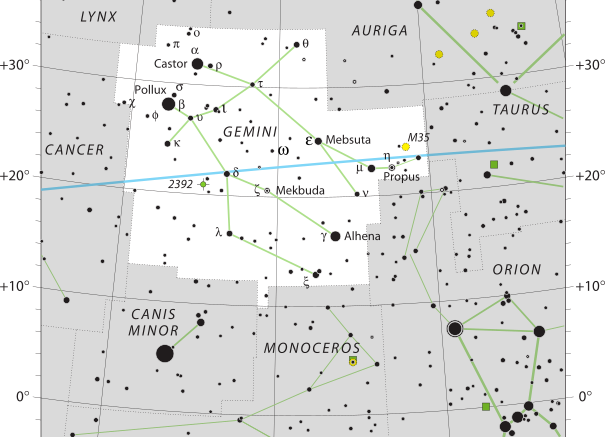Located in the northern celestial hemisphere, Gemini is a constellation of the zodiac and is 1 of the 48 constellations described by the 2nd century AD astronomer Ptolemy. The name Gemini is Latin for twins, and it is associated with the twins Castor and Pollux in Greek mythology.
The constellation is prominent in the winter skies of the northern Hemisphere and is visible the entire night in December-January
| Applicable Information | |
| Visibility In Pacific Northwest | September to April |
| Best Times To View | February |
| Right Ascension | 7h |
| Declination | +20° |
| Area | 514 square degrees |
| Main Stars | 8, 17 |
| Brightest Object | Pollux |
| Meteor showers | Geminids, Rho Geminids |
| Messier objects | 1 |
| Neighboring Constellations | Lynx, Auriga, Taurus, Orion, Monoceros, Canis Minor, Cancer |
Mythology
In Babylonian astronomy, the stars Castor and Pollux were known as the Great Twins, which were regarded as minor gods and were called Meshlamtaea and Lugalirra. These minor gods translate to ‘The One who has arisen from the Underworld’ and the ‘Mighty King.’
In Greek mythology, Gemini was associated with the myth of Castor and Pollux, the children of Leda and Argonauts both. Pollux was the son of Zeus, who seduced Leda, while Castor was the son of Tyndareus, king of Sparta and Leda’s husband. Castor and Pollux were also mythologically associated with St. Elmo’s fire in their role as the protectors of sailors. When Castor died, because he was mortal, Pollux begged his father Zeus to give Castor immortality, and he did, by uniting them together in the heavens.
In Chinese astronomy, the stars that correspond to Gemini are located in 2 areas: the White Tiger of the West and the Vermillion Bird of the South.
Stars
The constellation contains 85 stars of naked eye visibility.
The brightest star in Gemini is Pollux, with the second-brightest being Castor. Castor’s Bayer designation as “Alpha” arose because Johann Bayer did not carefully distinguish which of the two was the brighter when he assigned his eponymous designations in 1603.
M35 (NGC 2168) is a large, elongated open cluster of magnitude 5, discovered in the year 1745 by Swiss astronomer Philippe Loys de Chéseaux. It has an area of approximately 0.2 square degrees, the same size as the full moon. Its high magnitude means that M35 is visible to the unaided eye under dark skies; under brighter skies it is discernible in binoculars. The 200 stars of M35 are arranged in chains that curve throughout the cluster; it is 2800 light-years from Earth. Another open cluster in Gemini is NGC 2158. Visible in large amateur telescopes and very rich, it is more than 12,000 light-years from Earth.[6]
NGC 2392 is a planetary nebula with an overall magnitude of 9.2, which can be seen as a blue-green elliptical disk in a small amateur telescope.
Located 1500 light years from Earth, the Medusa Nebula is a planetary nebula. Other objects in the constellation include NGC 2129, NGC 2158, NGC 2266, NGC 2331, NGC 2355, and NGC 2395.
The Geminids are a bright meteor shower that peaks on December 13–14. It has a maximum rate of approximately 100 meteors per hour, making it one of the richest meteor showers.
Make sure to check out other articles on the site, including a brief introduction to constellations, other constellation articles, and more!

Be the first to comment on "Gemini"